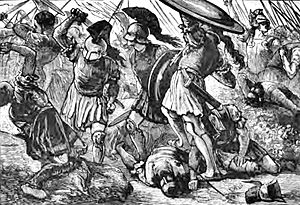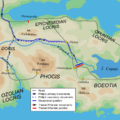Battle of Chaeronea facts for kids
Quick facts for kids Battle of Chaeronea |
|||||||||
|---|---|---|---|---|---|---|---|---|---|
|
An 1882 depiction of Battle of Chaeronea, from Cassell's Illustrated Universal History |
|||||||||
|
|||||||||
| Belligerents | |||||||||
| Macedon, Thessaly, Argos, Arcadia | Athens, Thebes, Corinth, Megara, Achaea, Chalcis, Epidaurus, Akarnania, , and Troezen | ||||||||
| Commanders and leaders | |||||||||
| Alexander | Chares of Athens, Lysicles of Athens, Theagenes of Boeotia |
||||||||
| Strength | |||||||||
| 30,000 infantry, 2,000 cavalry |
35,000 | ||||||||
| Casualties and losses | |||||||||
| unknown | ~2,000 dead, ~4,000 captured | ||||||||
The Battle of Chaeronea was a very important battle in Ancient Greece. It happened in 338 BC near a city called Chaeronea in a region known as Boeotia. This battle was fought between the powerful army of Philip II of Macedon and a group of Greek city-states. The main cities in this group were Athens and Thebes.
This battle was the final big fight in Philip's plan to control Greece. It ended with a clear victory for Macedon. This win changed the future of ancient Greece forever.
Contents
The Battle of Chaeronea: A Turning Point in Ancient Greece
The Battle of Chaeronea was not just another fight. It was a moment that changed who was in charge in ancient Greece. Before this battle, many Greek city-states were independent. They often fought among themselves.
After Chaeronea, the Kingdom of Macedon became the main power. This battle helped set the stage for the amazing conquests of Alexander the Great. He was Philip's son.
Who Fought in This Big Battle?
On one side was Philip II of Macedon. He was a very smart and strong king. Philip had built a powerful army. His army included a special fighting group called the Macedonian phalanx. This group used long spears.
Philip's son, Alexander, also fought in this battle. He was only 18 years old at the time. Alexander led the Macedonian cavalry, which were soldiers on horseback. This was one of his first big tests as a military leader.
On the other side was an alliance of Greek city-states. The two most important cities in this group were Athens and Thebes. Athens was known for its strong navy and its love of democracy. Thebes had a famous group of elite soldiers called the Sacred Band of Thebes.
The Athenian general was Chares of Athens. The Theban general was Theagenes. These leaders tried to unite the Greek cities against Philip.
Why Did They Fight?
Philip II wanted to bring all of Greece under his control. He believed that uniting the Greek city-states would make them stronger. He also wanted to lead them in a big war against the Persian Empire.
Many Greek city-states, especially Athens, were worried about Philip's growing power. They valued their freedom and independence. They saw Philip as a threat to their way of life.
A famous Athenian speaker named Demosthenes warned the Athenians about Philip. He urged them to fight for their freedom. This led to the formation of the alliance against Macedon.
The Day of the Battle
The battle took place on August 2, 338 BC. It was fought on a plain near the city of Chaeronea. Philip's army had about 30,000 foot soldiers and 2,000 cavalry. The Greek alliance had about 35,000 soldiers.
Philip used a clever plan. He pretended to pull back his own soldiers on one side. This made the Athenian soldiers push forward, breaking their battle line.
Alexander's Big Moment
While the Athenians were pushing forward, Alexander and his cavalry attacked the Theban forces. The Theban Sacred Band fought bravely. They were a group of 300 highly trained soldiers.
Alexander and his cavalry broke through the Theban lines. This was a very important moment in the battle. The Sacred Band was almost completely wiped out. This showed Alexander's skill as a young commander.
The Macedonian phalanx then attacked the now-broken Greek lines. The Greek forces were surrounded and defeated.
What Happened After the Battle?
The Battle of Chaeronea was a huge victory for Philip II. About 2,000 Greek soldiers died, and 4,000 were captured. Philip treated Athens fairly, but he punished Thebes more harshly.
This victory meant that Macedon was now the most powerful state in Greece. Philip formed the League of Corinth. This was an alliance of most Greek city-states, with Philip as its leader.
The battle ended the independence of many Greek city-states. It also paved the way for Alexander the Great's future campaigns. He would later use this united Greek army to conquer the Persian Empire.
Remembering Chaeronea Today
The Battle of Chaeronea is remembered as a turning point in ancient history. It marked the end of an era where Greek city-states were fully independent. It began a new period of Macedonian dominance.
A large stone lion statue, known as the Lion of Chaeronea, stands at the battle site. It is believed to be a memorial for the brave Theban Sacred Band who died fighting for their city.
Images for kids
-
Bust of Philip II of Macedon
-
Bust of the Athenian politician Demosthenes
-
Lion of Chaeronea, probably a Theban memorial.









